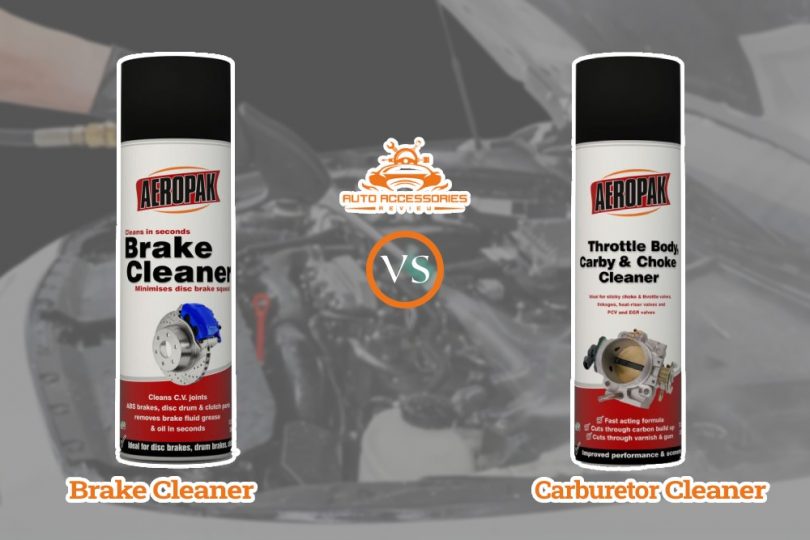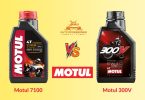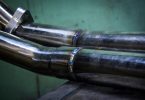Many people buy one cleaner when cleaning engine parts and want to use it for everything. While this sounds like a good idea, it is not. Engine components have different needs and require specific cleaning fluids.
Here we will look at how brake cleaners and carburetor cleaners differ and when you should use each.
Brake Cleaner Pros and Cons
Pros
- Oil-free
- Dries quickly
- Leaves no residue
Cons
- Cleans only brakes
- Damaging to rubber seals and gaskets, neoprene, plastic, and vinyl
Carburetor Cleaner Pros and Cons
Pros
- Oil-based
- Cleans carburetors and throttles
- Safe for rubber seals and gaskets, neoprene, plastic, and vinyl
Cons
- Takes longer to dry
- Cleans only carburetors unless you purchase a 2-in-1 cleaner
- Leaves residues
Brake Cleaner vs Carburetor Cleaner
1. Uses
Brake Cleaner
Your brakes are your best defense against accidents and skidding. Well-maintained brakes are essential, which includes cleaning them when needed. What you clean them with is important. You should use brake cleaner only when cleaning the brakes.
The brake cleaner is made to remove grease, brake fluid, and debris from brake components like calipers, rotors, drums, pads, and brake linings that are intact. Brakes need their surfaces to be oil-free to work properly.
Brake fluid comes in types:
- Chlorinated brake cleaner – may be harmful to vehicles and humans but is a comprehensive cleaner that leaves components extremely clean
- Non-chlorinated cleaner – not as toxic as a chlorinated cleaner. Great for removing grease but does not get the components as clean as a chlorinated brake cleaner
Carburetor Cleaner
Your carburetor helps maintain the correct fuel-to-air mixture in the combustion chamber that makes the combustion process possible. Carburetors are not as standard as they used to be and are increasingly being replaced with fuel injectors.
The formula for carburetor cleaner is very different from brake cleaner. The powerful chemicals in it remove dirt, grime, and varnish from the carburetor.
2. Ingredients
Brake Cleaner
Meant for metal and plastic only, a brake cleaner contains tetrachloroethylene and dichloromethane plus ethanols, isopropanol, methanol, and acetone.
Carburator Cleaner
While less toxic than brake cleaner, carburetor cleaner also contains harmful chemicals. These include xylene, ethylbenzene, acetone, and methanol. Carburetor cleaner is highly flammable and will melt nitrile gloves. Despite the powerful chemicals, it is safe for rubber and plastic.
3. Safety
Brake Cleaner
Some of the ingredients in brake cleaner are extremely toxic and possibly cancer-causing. You should wear gloves working with it.
Carburator Cleaner
While it is safer than brake cleaner, it can be harmful. Be careful where you spray carburetor cleaner. It will remove the paint off your car!
4. Cost
There isn’t much price difference between the two. A brake cleaner will cost you around $5 while a carburetor cleaner retail at $7.
How to Clean the Brakes Using Spray Brake Cleaner
Before starting, read the package directions. Wear gloves.
Step 1: With the car on a flat surface, jack up the car and remove the wheel.
Step 2: Thoroughly spray the brake calipers, discs, drums, and pads. Allow the spray to soak into the parts.
Step 3: Use a lint-free cloth and wipe off the loosened grime, debris, and any grease from the calipers, discs, drums, and pads. Make sure you have removed all the grime.
Step 4: Place the tire back on by replacing the lug nuts and tightening them. Lower the car to the ground and tighten the lug nuts till correctly tightened. Test drive the vehicle to ensure the brakes are working as they should.
How to Use Spray Carburetor Cleaner
Before starting, read the directions on the can. Apply safety glasses and non-nitrile gloves.
Step 1: Unscrew the wing nut on the air filter compartment. Remove the top and the air filter. Check the air filter. If it is too dirty to clean, it is time to replace it.
Step 2: Vacuum any dirt and debris from the engine top. You don’t want it getting into the engine while the air filter is not on.
Step 3: Spray the outside and the inside of the carburetor with the cleaner, allowing time to loosen and lift the dirt and varnish. Then use a clean cloth to remove the varnish and debris that has come loose.
Step 4: Start the car and while it is idling, spray into the carburetor and around the outside. As the carburetor cleans and burns off, you will hear the engine revving up. Wait a few more minutes, then shut the car off.
Step 5: Spray the inside and the outside of the carburetor a third time. Then restart the car and spray into the carburetor and on the outside again. Use another clean cloth to dry off the carburetor cleaner. Once dry, replace the air filter, replace the top and wingnut back on and retighten the wingnut.
When to Clean the Brakes?
Mushy brakes
Worn-out brake pads and hydraulic problems can cause this. It can also be dirty brake fluid, a warped rotor, and moisture in your brake fluid. Cleaning the brakes will let you examine the brakes and determine the problem.
Dashboard light
If a red or yellow light on the dash comes on, it is the brakes. This is an alert that there is a problem. Get them checked as soon as possible.
High-pitched squealing or grinding
No noise from the breaks is good, but grinding and high-pitched squealing should be checked as soon as possible. It’s usually dirt or grime, and a good cleaning may be all it needs.
A fluid leak
When the pedal goes down real easy (it feels soft), there is a chance your brake system leaks. Check immediately. Not being able to stop properly is an accident waiting to happen.
Vibrating
While some vibration is expected when you stop on a dime, vibrating when you apply the brake while driving may be a warped rotor. If cleaning doesn’t work, you should have the rotors checked to ensure your safety while braking.
Pulling to either side
There should be no pulling to the left or right when you brake. If you are feeling this, something is not right. It could be a caliper that is stuck or a brake hose issue, have this checked asap.
When to Clean the Carburetor?
Black smoke
Black smoke from your exhaust means there is an imbalance in the fuel-to-air mix (the engine is running rich), and the smoke is the gas burning off.
Misfires
A poor balance or air-to-fuel causes a popping noise or misfiring. The imbalance causes non-combustion in a chamber and makes this sound. This needs to be looked at now.
Flooded Engine
Overflowing fuel to counteract a poor air-to-fuel mix dampens the spark plugs causing the engine to fluid. Debris and grime clog the needle valve and stop it from closing.
Engine won’t start
The engine may crank and turnover but doesn’t start. It usually is a dirty carburetor. Check the air filter and clean the carburetor to fix this issue.
FAQs
1. Is a brake cleaner and a carburetor cleaner interchangeable?
Ans. No, they are not interchangeable. Each ingredient can only be used on certain surfaces and will damage or destroy electronic engine components.
2. Can I use a carburetor cleaner on a throttle body?
Ans. Some manufacturers make a cleaner for the carburetor and throttle body. If the can does not say to use it on the throttle body, then you should only use it on the carburetor.










Leave a Comment